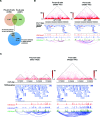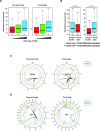Developmentally regulated higher-order chromatin interactions orchestrate B cell fate commitment
- PMID: 28977418
- PMCID: PMC5737614
- DOI: 10.1093/nar/gkx722
Developmentally regulated higher-order chromatin interactions orchestrate B cell fate commitment
Abstract
Genome organization in 3D nuclear-space is important for regulation of gene expression. However, the alterations of chromatin architecture that impinge on the B cell-fate choice of multi-potent progenitors are still unclear. By integrating in situ Hi-C analyses with epigenetic landscapes and genome-wide expression profiles, we tracked the changes in genome architecture as the cells transit from a progenitor to a committed state. We identified the genomic loci that undergo developmental switch between A and B compartments during B-cell fate determination. Furthermore, although, topologically associating domains (TADs) are stable, a significant number of TADs display structural alterations that are associated with changes in cis-regulatory interaction landscape. Finally, we demonstrate the potential roles for Ebf1 and its downstream factor, Pax5, in chromatin reorganization and transcription regulation. Collectively, our studies provide a general paradigm of the dynamic relationship between chromatin reorganization and lineage-specific gene expression pattern that dictates cell-fate determination.
© The Author(s) 2017. Published by Oxford University Press on behalf of Nucleic Acids Research.
Figures








Similar articles
-
Three-dimensional chromatin reorganization regulates B cell development during ageing.Nat Cell Biol. 2024 Jun;26(6):991-1002. doi: 10.1038/s41556-024-01424-9. Epub 2024 Jun 12. Nat Cell Biol. 2024. PMID: 38866970 Free PMC article.
-
Pioneering Activity of the C-Terminal Domain of EBF1 Shapes the Chromatin Landscape for B Cell Programming.Immunity. 2016 Mar 15;44(3):527-541. doi: 10.1016/j.immuni.2016.02.021. Immunity. 2016. PMID: 26982363
-
A Prion-like Domain in Transcription Factor EBF1 Promotes Phase Separation and Enables B Cell Programming of Progenitor Chromatin.Immunity. 2020 Dec 15;53(6):1151-1167.e6. doi: 10.1016/j.immuni.2020.10.009. Epub 2020 Nov 6. Immunity. 2020. PMID: 33159853
-
Defining B Cell Chromatin: Lessons from EBF1.Trends Genet. 2018 Apr;34(4):257-269. doi: 10.1016/j.tig.2017.12.014. Epub 2018 Jan 11. Trends Genet. 2018. PMID: 29336845 Review.
-
Complementary regulation of early B-lymphoid differentiation by genetic and epigenetic mechanisms.Int J Hematol. 2013 Oct;98(4):382-9. doi: 10.1007/s12185-013-1424-7. Epub 2013 Sep 3. Int J Hematol. 2013. PMID: 23999941 Review.
Cited by
-
Topoisomerase 2β and DNA topology during B cell development.Front Immunol. 2022 Aug 15;13:982870. doi: 10.3389/fimmu.2022.982870. eCollection 2022. Front Immunol. 2022. PMID: 36045673 Free PMC article.
-
Hierarchical chromatin features reveal the toxin production in Bungarus multicinctus.Chin Med. 2021 Sep 17;16(1):90. doi: 10.1186/s13020-021-00502-6. Chin Med. 2021. PMID: 34535171 Free PMC article.
-
Epigenetic dynamics in normal and malignant B cells: die a hero or live to become a villain.Curr Opin Immunol. 2019 Apr;57:15-22. doi: 10.1016/j.coi.2018.09.020. Epub 2018 Oct 17. Curr Opin Immunol. 2019. PMID: 30342313 Free PMC article. Review.
-
Differential genome organization revealed by comparative topological analysis of Mycobacterium tuberculosis strains H37Rv and H37Ra.mSystems. 2025 May 20;10(5):e0056224. doi: 10.1128/msystems.00562-24. Epub 2025 Apr 7. mSystems. 2025. PMID: 40192326 Free PMC article.
-
The dynamics of three-dimensional chromatin organization and phase separation in cell fate transitions and diseases.Cell Regen. 2022 Dec 21;11(1):42. doi: 10.1186/s13619-022-00145-4. Cell Regen. 2022. PMID: 36539553 Free PMC article. Review.
References
-
- Dekker J., Rippe K., Dekker M., Kleckner N.. Capturing chromosome conformation. Science. 2002; 295:1306–1311. - PubMed
-
- Dostie J., Richmond T.A., Arnaout R.A., Selzer R.R., Lee W.L., Honan T.A., Rubio E.D., Krumm A., Lamb J., Nusbaum C. et al. Chromosome Conformation Capture Carbon Copy (5C): a massively parallel solution for mapping interactions between genomic elements. Genome Res. 2006; 16:1299–1309. - PMC - PubMed
MeSH terms
Substances
LinkOut - more resources
Full Text Sources
Other Literature Sources
Molecular Biology Databases

